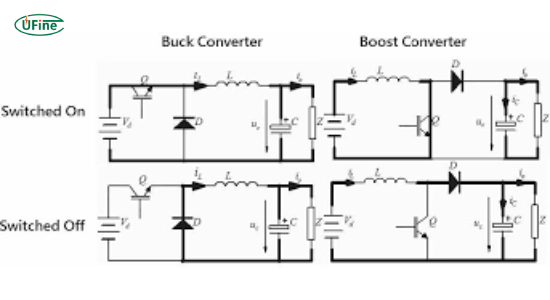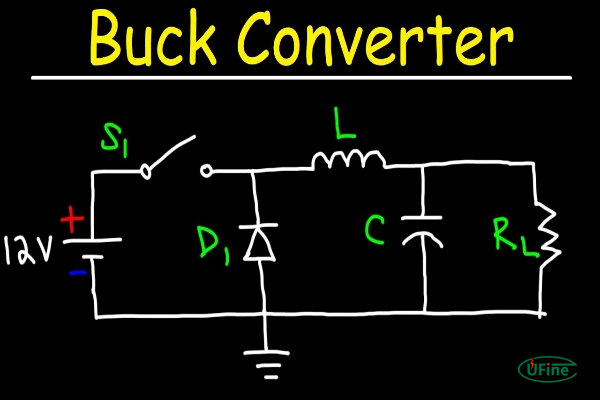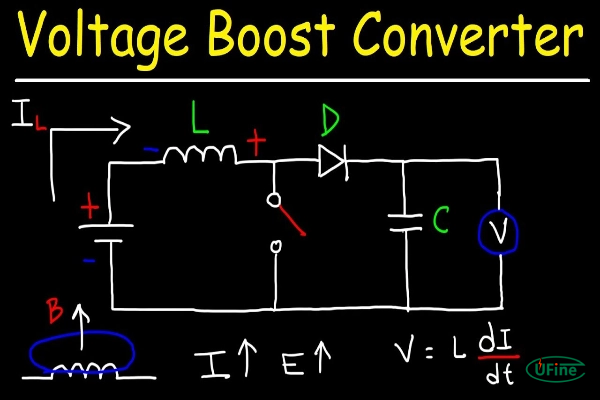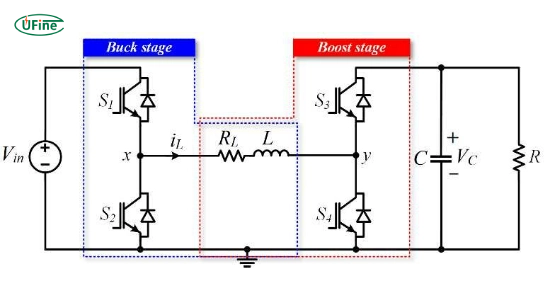In power electronics, buck converters and boost converters are pivotal in managing voltage levels efficiently. Whether you’re an electrical engineer, a tech enthusiast, or someone keen on understanding how modern electronic devices maintain optimal performance, this guide will demystify these crucial components. By the end of this article, you’ll realize what buck and boost converters are, how they operate, their applications, and why they are indispensable in today’s technology-driven world.
Part 1. Power converters
Power converters are devices that transform electrical energy from one form to another. They are essential in ensuring that various electronic devices receive the correct voltage and current they require. Designers widely use buck and boost converters due to their efficiency and versatility.
Part 2. What is a buck converter?
A buck converter, also known as a step-down converter, is a DC-DC converter that reduces the input voltage to a lower output voltage. It is highly efficient and widely used in applications with higher power supply voltage than the required operational voltage.
How Does a Buck Converter Work?
A buck converter operates by switching components, such as transistors, on and off rapidly. This switching generates a pulsating voltage, which an inductor and capacitor smooth out to produce a stable lower voltage. Here’s a simplified step-by-step process:
- Switch On: When the switch (usually a transistor) is on, current flows through the inductor, storing energy in its magnetic field.
- Switch Off: When the switch is off, the inductor releases its stored energy, maintaining the current flow through the load.
- Smoothing: A capacitor smooths the output voltage, resulting in a lower, stable DC voltage.
Advantages of Buck Converters
- High Efficiency: Buck converters are highly efficient, often exceeding 90%.
- Compact Size: Due to their high efficiency, they generate less heat, allowing for more compact designs.
- Cost-Effective: They are generally cheaper than linear regulators for the same power levels.
Applications of Buck Converters
Many applications use buck converters because of their efficiency and ability to decrease voltage. Some common uses include:
- Power Supply Units: In computers and other electronic devices to provide stable, lower voltages from a higher voltage source.
- Battery-Powered Devices: To extend battery life by efficiently stepping down the voltage.
- LED Drivers: To provide a constant current to LEDs, ensuring consistent brightness without flickering.
Example of a Buck Converter
- Smartphone Chargers: Modern smartphone chargers use buck converters to step down the high voltage from the wall outlet (typically 110V or 220V AC) to a lower DC voltage suitable for charging the battery (usually 5V or higher for fast charging technologies).
Part 3. What is a boost converter?
A boost converter, also known as a step-up converter, is a DC-DC converter that increases the input voltage to a higher output voltage. It is commonly used when the power supply voltage is lower than the voltage required by the device.
How Does a Boost Converter Work?
A boost converter operates on a principle similar to a buck converter but with a different configuration. Here’s how it works:
- Switch On: When the switch is on, current flows through the inductor, storing energy in its magnetic field.
- Switch Off: When the switch is off, the inductor releases its stored energy into the circuit, combining it with the input voltage to produce a higher output voltage.
- Smoothing: A capacitor smooths the output voltage, producing a higher, stable DC voltage.
Advantages of Boost Converters
- Voltage Increase: They can significantly increase the voltage from a lower input, which is helpful in battery-powered devices.
- High Efficiency: Like buck converters, boost converters are also highly efficient.
- Versatility: They are found in various applications, from small electronic devices to large power systems.
Applications of Boost Converters
Boost converters are equally essential in various applications that require increasing voltage. Common uses include:
- Portable Electronics: In devices like smartphones and tablets, boost the battery voltage for different components.
- Electric Vehicles: Step up the voltage from the car battery to drive the motor.
- Solar Power Systems: To increase the voltage from solar panels to match the requirements of the power grid or storage batteries.
Example of a Boost Converter
- Solar Battery Chargers: In solar power systems, boost converters increase the voltage from solar panels (which can vary based on sunlight exposure) to a higher, consistent voltage required to charge batteries efficiently.
Part 4. Critical components of buck and boost converters
Both buck and boost converters share several vital components that enable their operation. These include:
- Inductor: Stores and releases energy, crucial in voltage conversion.
- Switch: Usually, a transistor rapidly switches on and off to control the current flow.
- Diode: Allows current to flow in one direction, preventing backflow.
- Capacitor: Smooths out the voltage to produce a stable DC output.
Part 5. Factors affecting the efficiency of buck and boost converters
Efficiency is critical in the design and application of buck and boost converters. High efficiency, critical in battery-powered devices and applications with limited cooling capabilities, means that devices lose less energy as heat. Here are some factors that influence the efficiency of buck and boost converters:
- Switching Frequency: Higher switching frequencies can reduce the inductor and capacitor size but may increase switching losses.
- Component Quality: High-quality inductors, capacitors, and switches can minimize losses and improve efficiency.
- Load Conditions: Efficiency varies with load; converters are typically most efficient at a specific range of load currents.
- Thermal Management: Proper heat dissipation mechanisms, such as heat sinks or cooling fans, can maintain efficiency by preventing overheating.
Part 6. Design considerations for buck and boost converters
Designing an efficient and reliable buck or boost converter involves several critical considerations:
Input Voltage Range
Ensure the converter can handle the range of input voltages it will encounter in its application. For buck converters, the input voltage should always be higher than the output voltage. In contrast, for boost converters, the input should be lower.
Output Voltage Stability
The output voltage should remain stable under varying load conditions. This requires precise control of the switching elements and effective smoothing by the capacitor.
Switching Speed
The speed at which the switch operates affects the performance and size of the converter. Faster switching can reduce the size of the passive components but may increase electromagnetic interference (EMI) and switching losses.
Thermal Management
Proper thermal management is crucial to prevent overheating, which can degrade component performance and reduce the lifespan of the converter. This includes designing for adequate airflow, using heat sinks, or incorporating thermal shutdown features.
Control Methods
Different control methods can be employed to regulate the output voltage, such as:
- Pulse Width Modulation (PWM): Adjusts the duty cycle of the switch to control the output voltage.
- Current Mode Control: Controls the current through the inductor to maintain the desired output voltage.
- Voltage Mode Control: Regulates the output voltage directly by comparing it to a reference voltage.
Part 7. Challenges in buck and boost converter design
Designing these converters comes with its set of challenges:
Electromagnetic Interference (EMI)
High-frequency switching can generate EMI, which can interfere with other electronic devices. Shielding and filtering techniques are essential to mitigate this issue.
Component Stress
Switching components like transistors and diodes are subjected to high stress, which can fail if not adequately managed. Selecting components with appropriate ratings and ensuring proper heat dissipation is crucial.
Efficiency vs Cost
Achieving high efficiency often involves using more expensive components and advanced control techniques, which can increase the overall cost. Balancing efficiency and cost is a crucial design consideration.
Part 8. Conclusion
By mastering the principles and applications of buck and boost converters, engineers and tech enthusiasts can innovate and improve the power efficiency of countless devices, driving forward the capabilities of modern technology.
Related Tags:
More Articles

LiPo Battery Discharge Rate Guide & Calculation Tips
Understand LiPo battery discharge rates, C-ratings, and how to calculate max current. Essential guide for RC, drones, and electronics users.
High‑Capacity 3S LiPo Batteries: 5000 mAh vs. 10000 mAh
Compare 3S LiPo 5000mAh vs 10000mAh batteries by weight, power, and use. Find the best fit for your drone, RC car, or boat setup.
Top 5 Applications for Small 3S LiPo Batteries
Small 3S LiPo batteries power drones, RC gear, wearables, and robotics with high energy and low weight. Making them ideal for compact electronics projects.
Building and Charging Your Own 3S LiPo Pack: A Step‑by‑Step Guide
Learn how to build, balance, and charge a 3S LiPo battery pack safely at home with this complete DIY guide for hobbyists and beginners.
How to Choose the Right LiPo Battery Plug Type?
Discover the best LiPo battery plug types, how to choose them, and expert tips for safe usage, soldering, and maintenance.







